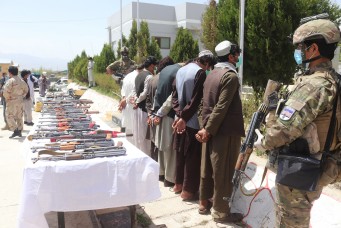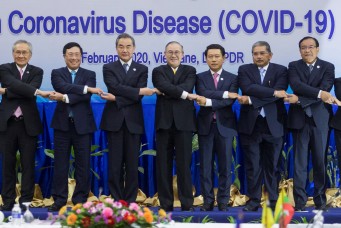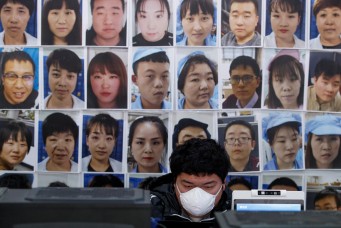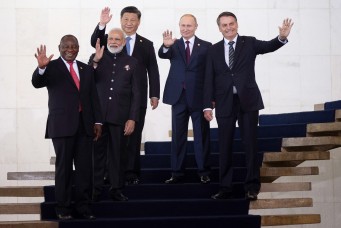COVID-19: America, China and the Conspiracy War
The two rival powers have been at loggerheads about the spread of the novel coronavirus, but maybe it’s time they cooperate for the greater good.

As COVID-19 rampages across the world, it is quickly becoming a new tool of exploitation and intimidation in the U.S.-China power struggle. With conspiracy theories about the coronavirus generating and multiplying on both sides of the Pacific and elsewhere, both the Chinese Communist Party (CCP) and the U.S. government are competing to control the narrative and use it for their own gains. With their war of words escalating, COVID-19 brings a two-year trade dispute between the world’s two largest economies—which was just resolved in January—to a new low, with nationalistic rhetoric running high in both countries.
But it wasn’t always that way.
As China was grappling with a high infection rate in January and February, Trump appeared supportive of the Beijing leadership. On January 24, he tweeted:
China has been working very hard to contain the Coronavirus. The United States greatly appreciates their efforts and transparency. It will all work out well. In particular, on behalf of the American People, I want to thank President Xi!
— Donald J. Trump (@realDonaldTrump) January 24, 2020
In a Fox Business interview on February 10, Trump continued to praise China’s handling of the virus.
“I think China is very, you know, professionally run in the sense that they have everything under control,” Trump said.
Within weeks, however, this position began to change.
On February 25, U.S. Secretary of State Mike Pompeo used a press conference to accuse China of censoring information, and blamed it for the world’s lack of preparedness to deal with the coronavirus spread.
“Had China permitted its own and foreign journalists and medical personnel to speak and investigate freely, Chinese officials and other nations would have been far better prepared to address the [COVID-19] challenge,” he said.
This effectively signaled an end to Trump’s praising of China, just as domestic criticism of his administration’s ability to handle the virus ramped up and the reelection campaign neared. In March, Trump and his Republican supporters began to take a very different attitude toward China.
“I wish [China] could have told us earlier about what was going on inside… but I wish they could have told us earlier about it because we could have come up with a solution,” Trump said during a White House briefing on March 21. He added that China “was very secretive and that’s unfortunate”.
On April 27, the U.S. president fired a volley of attacks against Beijing, hinting that he would launch an investigation into China’s alleged role in spreading the virus. In response to a question regarding a German newspaper editorial demanding that China pay Germany $165 billion in coronavirus-related damages, Trump implied that the United States would do the same in attempts to hold China accountable for the spread of the pandemic.
“Germany is looking at things, we are looking at things… We are talking about a lot more money than Germany’s talking about,” he said.
Three days later, when asked by a reporter at the White House about COVID-19 allegedly originating from the Wuhan Institute of Virology (WIV), Trump implied that the World Health Organization (WHO) was being paid by China to cover up for them. “I think that the World Health Organization should be ashamed of themselves, because they’re like the public relations for China,” Trump said.
On May 3, in an interview with ABC’s This Week, Pompeo fell in line, saying that there was a significant amount of evidence that COVID-19 came from “that laboratory in Wuhan”.
While the U.S. administration continues to criticize and blame China for the global spread of the virus, China has at times had a more weathered response: critical of the American rhetoric, but also urging multilateral cooperation. Xi has been seen urging international cooperation to combat COVID-19 on multiple occasions.
One such occasion took place on February 3, when Xi gave a speech at the Standing Committee of the Central Political Bureau of the Communist Party’s Central Committee in response to the pandemic.
“We have to liaise and communicate with other countries and regions to share information about the outbreak and containment strategies to win international understanding and support,” he said.
However, like the United States, the Chinese approach also slowly began to change. On April 28, Deputy Director of the Foreign Ministry Information Department Geng Shuang said, “American politicians ‘spit the pot’ to China, which will not wipe out the anti-epidemic achievements of the Chinese people through hard work”.
Two days later, state-run news agency Xinhua posted a video mocking the U.S. response to the pandemic. It seemed that the war of words was increasing in vitriol.
Manipulating Crises and Conspiracies
During the 1918 flu pandemic, which is estimated to have killed at least fifty million people worldwide, conspiracy theories surfaced as people struggled to make sense of the deaths. Some believed it was a weapon of war from a German ship, other accounts claimed Germans carried it in vials filled with germs, and others yet believed in a big pharma conspiracy theory that the pandemic was the invention of the German pharmaceutical firm Bayer, which had in 1899 originally patented aspirin, which was found to be the “wonder drug” that could cure it.
More than one hundred years later, and since the first COVID-19 infections were reported in December 2019, social media similarly exploded with conspiracy theories to explain the virus and its global reach and impact.
Among the first theories to emerge was that the coronavirus was a hoax, perpetuated either by the Americans or the Chinese to destroy the world economy. This—with the Chinese in the headlights—was a favorite of Trump supporters; on February 28, at a campaign rally in South Carolina, Trump said, “the Democrats are politicizing the coronavirus… this is their new hoax”.
In the Middle East, one popular theory was that the Americans had designed COVID-19 in a lab to destroy both China and Iran; in the early days of the spread, Tehran was overwhelmed with infections and deaths.
Various conspiracy theories related to COVID-19 began in fringe media outlets in Europe, including the belief that 5G mobile networks spread the virus by lowering the immune system, or that radiation from 5G towers transmits the virus.
Then there was the one about a worldwide conspiracy to create a new world order through biochip vaccines, all designed by one famous computer machine founder.
Several of these theories moved from fringe right-wing conspiracy theorists to mainstream media. The “Bill Gates” conspiracy, which quickly made its way to Fox News through host Laura Ingraham, is one such example. The conspiracy theory claims that Gates’ warning of a future worldwide pandemic during his Ted Talk in 2015 is proof enough that the Microsoft founder is behind COVID-19.
Anti-vaccine conspiracy theorists, likely the ones already warning against the measles and polio vaccines, warn that any future COVID-19 vaccine will be a ruse from the “new world order” to control populations, or that the vaccine fits into an overall master plan for mass enslavement and surveillance.
Furthermore, in a repeat of 1918, a “big pharma” conspiracy theory about COVID-19 has been spread by media pundits like Alex Jones, who points to pharmaceutical giants and face mask manufacturers enjoying a huge surge in stocks and prices.
These conspiracy theories have larger societal implications. The “5G” conspiracy theory has led to arson attacks in the United Kingdom, with communication masts being set on fire. Far-right activists have exploited the 5G conspiracy theories to their own aims of promoting anti-Semitic sentiment. Anti-vaccination sentiments hold potential dangers in hindering the process of battling the virus once a vaccine has been found.
Conspiracy theories usually thrive when they provide some a sense of control and comfort in times of chaos, having sparse elements of the truth. Once conspiracy theories have found an audience and become widespread, and their authors appear on mainstream networks or YouTube, the discourse is no longer about proving or disproving the theories themselves, but convincing and seizing the narrative in a warf against misconceptions, misinformation, and myths.
There has been a global push to blame China for the situation we face today. Sky News Australia contributor Mike Jeffreys says he “wouldn’t trust anything coming out of” China, while another Sky News affiliate, Rowan Dean, has said that “China willfully inflicted” the virus upon the world, going further to say “this is an inevitable consequence of communism and totalitarianism”.
Similarly, as cases rose in Iran, the ruling clerics joined the information battlefield, claiming that COVID-19 was a U.S. biological weapon targeting Iran and/or benefitting its big pharma industry. Hossein Salami, the commander of the Revolutionary Guard, said the virus may be an “American biological invasion”.
Yet, there has been no evidence to support any of these theories.
“There is no evidence that this is a conspiracy that the Chinese somehow invented the virus and spread it to the rest of the world,” says Steve Tsang, director of the SOAS China Institute (SCI).
Nevertheless, both American and Chinese pundits began exchanging blame for the origins of the COVID-19 crisis via mainstreamed conspiracy theory.
For example, outspoken Chinese Deputy Director of the Foreign Ministry Information Department, Zhao Lijian, tweeted on March 12: “…It might be the U.S. Army who brought the epidemic to Wuhan. Be transparent! Make public your data! The United States owes us an explanation!”
On April 30, the U.S. Office of the Director of National Intelligence issued a statement that the virus “was not man-made or genetically modified,” but conspiracy theorists still insist that COVID-19 was manufactured in a lab.
Trump himself fuels the conspiracy theory of the virus having originated from the WIV. When asked by a reporter on April 30 if he had seen evidence linking the virus to the WIV, Trump said, “Yes, I have.”
“Both U.S. and Chinese leaders for the moment are just interested in scoring points—from the Chinese Spokesman who said the virus originated with the U.S. Army to the Americans trying to convince the G7 to call it the Wuhan Virus,” says Richard Boucher, Senior Fellow in International and Public Affairs at Brown University.
Nis Grünberg, an analyst at the Mercator Institute for China Studies, says that politicians in leading positions have the responsibility to make decisions beneficial for the public interest.
“Nobody, but especially not politicians, should pick up conspiracy theories that have no evidence to them,” he told The Cairo Review.
“Some might argue politicians often are representatives of particular interests, but a nation’s political leadership has a broader responsibility to its people,” Grünberg added.
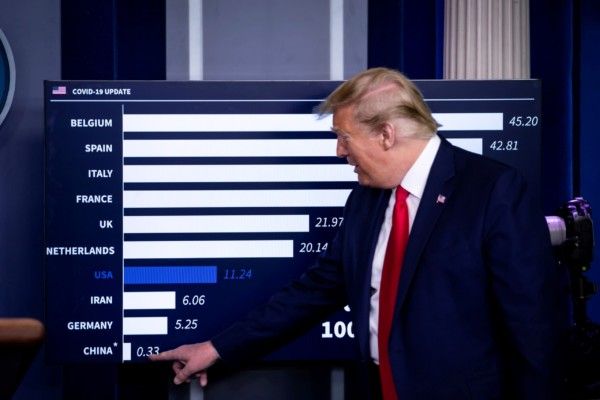
A Lost Opportunity
In the midst of trading barbs and fueling conspiracy theories—whether intentional or as a byproduct of their recent trade rivalry—most experts agree that both countries have sacrificed the opportunity to push for multilateralism and international cooperation at the altar of nationalism and domestic consumption.
In the battle for control of the narratives surrounding COVID-19, Professor Olivia Cheung from SCI believes Beijing has strategically framed COVID-19 in “U.S. versus China” terms,” which has been “instrumental in galvanizing nationalism and bolstering the Party’s image as the defender of the Chinese nation—which was urgently needed to redeem the damage COVID-19 did to its legitimacy and, in particular, Xi’s personal authority”.
Tsang says that Beijing squandered an enormous opportunity to proclaim and consolidate its soft power. “If they [China] had behaved like a normal, responsible, great power, and had turned their attention to producing all the PPEs [protective personal equipment] and exported them at the prices of pre-COVID-19 level, with a transparent framework … and given these, for free, to countries in Africa and Central Asia and the Middle East which cannot afford to pay for them, how much appreciation would they have gained from countries that cannot afford to pay for them?”
China not only had the opportunity to assert and extend its soft power during the rise of the pandemic, but had the “institutional memory” from past pandemics, such as 2003’s Severe Acute Respiratory Syndrome (SARS), to respond effectively and quickly to the virus in Wuhan as it first began to spread.
The first misstep in a bid to protect its global prestige came on January 23, when the lockdown began in Wuhan. Although the Chinese government knew already that five million of the eleven million people had already left the city ahead of the New Year, it still requested countries around the world not to deny entry to Chinese travelers.
This was quickly followed by the government reprimand of Chinese doctor Li Wenliang, who first alerted the world about the COVID-19 coronavirus. Beijing accused him of spreading “false information” and he was investigated. His death on February 7, reportedly from the virus, spawned trending hashtags on Twitter calling for justice and freedom of speech. These hashtags were systematically censored, but nevertheless Li quickly became revered as a fallen hero; his death became the most read topic on Weibo, a Chinese Twitter-like networking site.
BBC News’ China correspondent reported at the time that how he was treated and his eventual death was an “epic political disaster”.
China’s Propaganda Campaign
In the meantime, China’s propaganda campaign has been “focusing on ‘telling positive stories in its fight against the epidemic’ and the CCP’s indispensable role leading the fight”, says Grünberg.
General Wang Ning, who is currently the commander of the People’s Armed Police, posted an article on February 10 on the Ministry of Defense of the People’s Republic of China (PRC) website with the beginning, “good stories attract people, move people, inspire people”. An impassioned call to action to the citizens of China, to “impress the masses with truth” in an era of “self-media where ‘everyone has a microphone’”.
Shortly after, Vice Premier of the PRC Sun Chunlan published an article in Qiushi, the CCP’s main theoretical outlet, stating: “China’s response to the epidemic clearly illustrates the political advantage of the CCP, and the institutional advantage of socialism with Chinese characteristics”.
The utility of telling positive stories here plays into China’s victimization narrative. CCTV’s page “Wuhan, China” displays a first-person narrative of Wuhan personified and of its suffering during the lockdown. The text is rich in victimization and themes of solidarity: “I am Wuhan. Though under lockdown, I don’t feel alone.”
Sinophobia—or anti-Chinese sentiment, which has witnessed a global rise as a consequence of COVID-19 having originated in Wuhan—redefines the lens of “us-versus-them” to now read the “outside world” as the transgressor and China as the victim.
Historians have traced China’s victimization narrative as far back to the first opium war between the Qing Dynasty and Western forces from 1839–1842, including the second Sino-Japanese War from 1937–1945, although this theme has become most potent since the Chinese Communist Revolution in 1949.
Anthony Saich, Professor of International Affairs at Harvard University, believes this narrative is one “of national humiliation and the CCP’s revolution that brought independence”. This has “been a key component of the legitimizing story that the Party tells”, Saich says.
Public opinion about government handling of the virus began to turn once considerable international criticism grew,” Saich added, almost as though only the people and citizens of China may criticize the CCP, while outsiders may not.
The Chinese propaganda campaign included allegations that the United States had started the virus and transported it to China via the U.S. Army, that the virus started in Italy, or that China is giving away large amounts of PPEs to other countries when, in actuality, most were being sold.
On May 4, the hundredth anniversary of the 1919 May Fourth Movement in Beijing to counter Western imperialism in China, Xi delivered a speech urging the country’s youth to “work hard for the realization of the Chinese dream for national rejuvenation.” Using the movement to strengthen patriotism, Xi said, “In the new era, China’s youth must listen to the Party, follow the Party, care for the country and people, devote themselves, and strive for patriotism”.
America Mirrors China?
In a similar vein, the “United States versus China” framework is an essential component of the current U.S. administration’s political rhetoric targeted at American voters. A focus on U.S. competition with China and China-bashing is at the center of Trump’s election campaign. The uncertainty and upheaval of COVID-19 has come at a prime time with the upcoming November 2020 presidential election, feeding into the “United States versus China” political rhetoric.
Furthermore, the U.S. leadership scapegoated Chinese people by repeatedly referring to COVID-19 as the “Chinese Virus” and “Wuhan Virus”, including a White House official who referred to it as “Kung Flu”. Pompeo’s allegation that China has destroyed COVID-19 samples, alongside his constant referral to COVID-19 as the “Wuhan Virus”, has further escalated the diplomatic spat between the two most powerful countries in the world.
The administration’s position blaming China shifts attention away from its own lack of decisive measures against the virus, including the rather ineffective travel ban on flights coming from China and the dismissal of the Centers for Disease Control and Prevention’s (CDC) advice for the use of face masks early on in the crisis.
In the United States today, there are more than 132,000 reported deaths, among 2.9 million confirmed COVID-19 cases. Employment has reached staggering levels with 30 million out of their jobs, doubling the total number of jobs lost during the Great Recession.
Meanwhile, the media criticism has been merciless. Republicans and Trump supporters have fired back by pinning the blame on China for the spread of the virus; in an attempt to win the reelection campaign, they have exploited preexisting animosities like trade tensions and rivalry over the South China Sea toward Beijing.
“President Trump is reacting to his leadership failures on the coronavirus in the same way that he always does—by looking for someone else to blame. China fits the bill,” Jeff Colgan, Professor of International Affairs at Brown University, told The Cairo Review.
The shortcomings of the current U.S administration and the criticism it faces places it on par with China’s inability to capitalize on opportunity. The current administration’s isolationist tendencies will have long-lasting consequences in the global fight against the virus, but also on the world’s view of the United States.
The inability of the United States to lead during a time of global crisis has come under glaring scrutiny. “The Trump administration was clearly not prepared for the COVID-19 crisis, says Brown University Senior Fellow and diplomat Brian Atwood.
He says there is clear evidence that the White House ignored guidelines prepared by the previous administration, including ignoring the Obama administration’s efforts to cooperate directly with China.
Atwood believes that had the current administration continued its predecessor’s approach, China may not have been able to cover up the seriousness of the virus in the beginning.
The consequence of this “is costing lives at a time when international cooperation and U.S. leadership is badly needed,” he says.
In the Long Run
In the long run, despite the CCP initially censoring alarm bells by suppressing people like Li Wenliang, China’s efficiency and strict top-down response arguably helped control an outbreak more successfully than many other countries, including developed first world countries in Europe.
Wuhan’s initial complete lockdown drew the criticisms of policymakers and experts as “draconian” and doomed to fail, only to later be seen as the best way to flatten the curve of transmission and infection. Aggressive restrictions and policing took place in China, including, in some cases, officials going door to door for health checks, and residential compounds no longer allowing anyone but the residents inside.
Meanwhile, “you have a world that was ready, and has been ready for the last seventy years or so, to look to America for leadership, in a moment of crisis,” Tsang said. The United States has been noticeably absent in picking up the reigns during this global pandemic, with Trump quietly asking South Korea to send test kits.
In contrast, China’s “mask diplomacy” exists as an attempt to claim global health leadership, albeit a floundering attempt. China claimed to have given two million masks to Italy as well as having provided Spain with medical aid and advisors using the “Health Silk Road”, a metaphorical extension of China’s One Belt One Road Initiative (BRI). On March 21, 110,000 medical masks and 776 protective suits arrived in Spain.
However, the quality of goods sent and exported from China have been reported to be faulty, resulting in fifty thousand testing kits that were sent to Spain being discarded, and other issues were found with defective testing kits and face masks in Turkey, and the Netherlands as well. This inevitably backfired on China’s grasp for global health leadership.
But is it too little too late for China to redeem itself in the eyes of the rest of the world? The unforeseen consequences of an aggressive propaganda campaign created a lot of anger, Tsang told The Cairo Review, and “will ultimately backfire on China.”
Tsang further warned that the world might see more industries and manufacturing of essential goods shift away from China in a move towards economic decoupling, as China has proved when “the ships are down” to be an “unreliable source of manufacturing for essential and medical supplies.”
This would solidify Trump’s strategy toward China, which he began advocating in August 2019 by implementing tariffs, including the 15 percent taxes that were applied to approximately $112 billion Chinese imports.
In late August, Trump tweeted about his “Buy American” campaign:
Our Country has lost, stupidly, Trillions of Dollars with China over many years. They have stolen our Intellectual Property at a rate of Hundreds of Billions of Dollars a year, & they want to continue. I won’t let that happen! We don’t need China and, frankly, would be far….
— Donald J. Trump (@realDonaldTrump) August 23, 2019
This is part of a larger trend of countries “pushing back on China’s economic policies, trade practices, ‘made in China 2025’, BRI investments, etc, and more aggressive moves in the waters in the South,” Saich says.
Several Chinese spokesmen and officials are pushing to leave the blame game behind and to focus on cooperation together in battling COVID-19, sharing resources, medical information and scientific discoveries as they relate to battling the virus.
Both Foreign Ministry Information Department Deputy Minister Geng Shuang and Cui TianKai, Chinese ambassador to the United States, have condemned those spreading conspiracy theories.
On March 18, Geng said: “We hope that those on the U.S. side will respect facts, science, and international consensus, stop attacking and blaming China for nothing, stop making irresponsible remarks, and focus instead on fighting the epidemic at home and promoting international cooperation.”
On April 22, Cui drove home that point when he said “It’s clear if our two countries can cooperate with each other, both will benefit. If we have confrontation, both will lose.”
Experts from all over the world agree that cooperation is of utmost importance. As Boucher said, “both sides should understand, especially from this pandemic, how we can’t separate, we can’t ‘decouple’, and alone each of us ends up worse off”; the solution is to “find a more stable way to cooperate and to handle our economic relations”.
Furthermore, U.S. and Chinese tensions over COVID-19 “could harm cooperation on much more important long term issues, especially climate change,” said Grünberg, as the pandemic is occurring among a variety of other global issues which also call for cooperation.
Amanda Tapp is a researcher reporter at the Cairo Review of Global Affairs.
Read More
